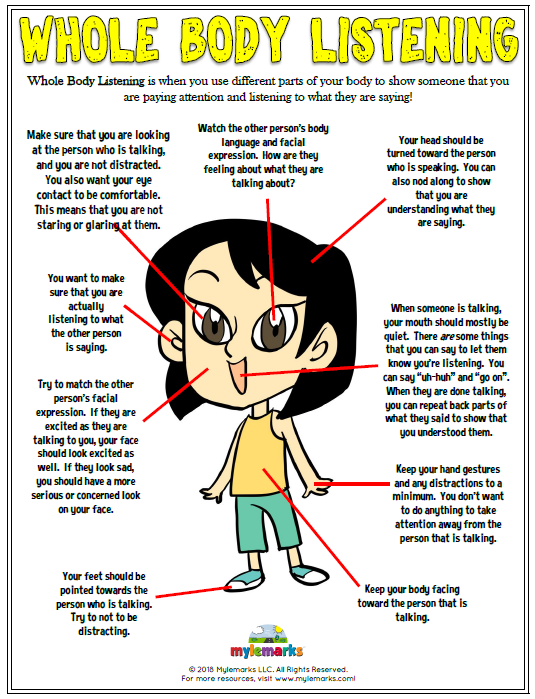

Students will also be observed in various locations throughout the school year and complimented as deserved. Counselor and Kennedy will compliment those who are using whole body listening. Follow up if needed.Ĭounselor and Kennedy will visit classes, unannounced, to observe how the students are using whole body listening.

Look at how the students have answered the “Kennedy’s Whole Body Listening” worksheet.Īsk teachers to report how students are doing with listening after this lesson. Pass out the worksheets for them to fill out correctly. Have students demonstrate THEIR whole body listening by sitting on the carpet, sitting at their desks, standing in line, and any other examples appropriate to the particular class. What are the 4 aspects of effective listening 27. What is the difference between hearing and listening 26. What should be avoided for effective listening 25. Discuss how well Kennedy listens and uses his whole body by watching Kennedy and also looking at the worksheet that shows him using whole body listening skills. What are the 5 most common barriers to effective listening 23. Give multiple commands and reward him with treats. As the lesson is being taught, point out how Kennedy is using whole body listening.Īfter discussing how we use our whole body to listen, have Kennedy show the students how well he can listen. Ask students, “How can your whole body play a part in good listening?” Answers should include that hands and feet need to be still so they do not distract the eyes and brain from thinking about what the speaker saying. Read a story to the class about the importance of listening and making a good choice to listen.
#WHOLE BODY LISTENING PDF#
Worksheet ( Kennedy’s Whole Body Listening – Page Three of PDF attached below) Students will practice whole body listening.īook about the importance of listening (see above as suggestion) Students will identify what whole body listening looks like, using Kennedy as a model. Wigglebottom Learns to Listen, Howard Binkow) Students will listen to a story about the importance of listening.

You are saying, 'I am ready to listen' without having to actually say anything.Tiffin City Schools, Tiffin, OH / Kennedy These six things are visual cues you can give the person that is speaking. If you are playing with or touching something, your focus leaves the speaker and redirects itself to the thing in or on your hands. They should be in your lap, by your sides, or in your pockets. When you speak when others are talking, you keep others around you from being able to fully pay attention. It is almost impossible to hear what someone else is saying if you are talking. In order to listen with your whole body, you should also remain silent.

This is your way of telling the speaker that you are preparing to hear what is going to be said. Your feet must also be flat on the floor, and your body should be facing the person who is talking.
#WHOLE BODY LISTENING FULL#
Looking around the room is not giving your full attention to the person who is talking, and you may miss something that is important. To hear, your eyes must be focused on who is speaking. In whole body listening, your ears have to be ready to hear, but it's hard to hear when the rest of your body is not prepared. Each part plays a specific role so that you can truly focus, hear, and understand what is being said. It means also using your eyes, feet, body, mouth, brain, hands, and heart. Whole body listening involves more than just using your ears.


 0 kommentar(er)
0 kommentar(er)
